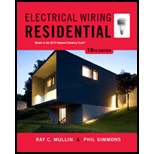
Electrical Wiring Residential
18th Edition
ISBN: 9781285170954
Author: Ray C. Mullin, Phil Simmons
Publisher: Cengage Learning
expand_more
expand_more
format_list_bulleted
Concept explainers
Question
Chapter 19.2, Problem 16R
a.
To determine
State the wire size utilized to connect the water heater.
b.
To determine
State the size of overcurrent device (OCD) .
Expert Solution & Answer
Trending nowThis is a popular solution!

Students have asked these similar questions
Don't use ai to answer I will report you answer
Don't use ai to answer I will report you answer
Don't use ai to answer I will report you answer
Chapter 19 Solutions
Electrical Wiring Residential
Ch. 19.1 - Does a jet pump have any electrical moving parts...Ch. 19.1 - Prob. 2RCh. 19.1 - Where is the jet of the pump located?...Ch. 19.1 - Prob. 4RCh. 19.1 - Prob. 5RCh. 19.1 - Prob. 6RCh. 19.1 - Prob. 7RCh. 19.1 - What is compressed in the water storage tank?...Ch. 19.1 - Explain the difference between a 2-wire...Ch. 19.1 - Prob. 10R
Ch. 19.1 - Why is a 240-volt motor preferable to a 120-volt...Ch. 19.1 - How many amperes does a 1-horsepower, 240-volt,...Ch. 19.1 - What size are the conductors used for this branch...Ch. 19.1 - Prob. 14RCh. 19.1 - What provides the running overload protection for...Ch. 19.1 - What is the maximum ampere setting permitted for...Ch. 19.1 - Prob. 17RCh. 19.1 - Because the controller contains the motor starting...Ch. 19.1 - Prob. 19RCh. 19.1 - Proper pressure of the submersible pump system is...Ch. 19.1 - Fill in the data for a 16-ampere electric motor,...Ch. 19.1 - The NEC is very specific in its requirement that...Ch. 19.1 - Does the NEC allow submersible pump cable to be...Ch. 19.1 - Must the disconnect switch for a submersible pump...Ch. 19.1 - A metal well casing (shall) (shall not) be bonded...Ch. 19.2 - Prob. 1RCh. 19.2 - A major hazard involved with water heaters is that...Ch. 19.2 - Prob. 3RCh. 19.2 - The heating elements in electric water heaters are...Ch. 19.2 - An 80-gallon electric water heater is energized...Ch. 19.2 - Prob. 6RCh. 19.2 - For residential water heaters, the Consumer...Ch. 19.2 - An 80-gallon electric water heater has 60F...Ch. 19.2 - Approximately how long would it take to produce...Ch. 19.2 - Two thermostats are generally used in an electric...Ch. 19.2 - a. How many heating elements are provided in the...Ch. 19.2 - When does the lower heating element operate?...Ch. 19.2 - Prob. 14RCh. 19.2 - Prob. 15RCh. 19.2 - Prob. 16RCh. 19.2 - a. If both elements of the water heater in this...Ch. 19.2 - a. How much power in watts would the two elements...Ch. 19.2 - A condominium owner complains of not getting...Ch. 19.2 - For a single, nonmotor-operated electrical...Ch. 19.2 - A 7000-watt resistance-type heating appliance is...Ch. 19.2 - Prob. 22R
Knowledge Booster
Learn more about
Need a deep-dive on the concept behind this application? Look no further. Learn more about this topic, electrical-engineering and related others by exploring similar questions and additional content below.Similar questions
- In Experiment PD controller How would the equation become if it were Kp=1 KD=0/0.1/0.5/1/10 s+1 0.02s+1arrow_forwardDon't use ai to answer I will report you answerarrow_forward4. Discussion: GINEE Compare between theoretical combination effect of Kp and KD at first order and second order systems regarding steady-state errors and transient responses with the practical obtained results whenever applying step input signalın Experiment PD controller و المهندسة الكهربائيةarrow_forward
- b C Is 3601116-67 Bre ✓ BIb ≤5K 20k e 0-25K 7. Zo Z Zb B=100, Ble=1Kr Zb=S & Zin = S, Zo=S, AV=Sarrow_forwardDon't use ai to answer I will report you answerarrow_forward4. Discussion: GINEE Compare between theoretical combination effect of Kp and KD at first order and second order systems regarding steady-state errors and transient responses with the practical obtained results whenever applying step input signalın Experiment PI controller و الهندسة الكهربائيةarrow_forward
- همسة 4. Discussion: Compare between theoretical combination effect of Kp, KI and KD at second order systems regarding steady-state errors and transient responses with the practical obtained results whenever applying step input signalln Experiment PID Controllerarrow_forwardHi there! I’m working on some practice questions and would appreciate your help. I’ve uploaded two images: the first contains the initial questions (with the second part also typed out below), and the second image shows the final section of the worksheet. Could you please assist me with these?THE QUESTION NUMBERS ARE IN ORDER. 1b). Suppose the flip-flops are 74F74 devices and the AND gates are 74F08 devices. Let maxtpd,D=9ns, maxtsu,D=3ns, and maxtpd,AND=6ns. What is the maximum clock frequency at which the circuit can operate reliably? 2. Compare serial transmission and parallel transmission and discuss their advantages and disadvantages. 3. Explain briefly how the slave can protect itself from being overwhelmed by the master in I2 4. A hypothetical logic family has the following specifications. VOH=4.6V VIH=4.0V VOL=0.5V…arrow_forwardهمسة 4. Discussion: Compare between theoretical combination effect of Kp, KI and KD at second order systems regarding steady-state errors and transient responses with the practical obtained results whenever applying step input signal in Experiment PI Controllerarrow_forward
arrow_back_ios
SEE MORE QUESTIONS
arrow_forward_ios
Recommended textbooks for you
 EBK ELECTRICAL WIRING RESIDENTIALElectrical EngineeringISBN:9781337516549Author:SimmonsPublisher:CENGAGE LEARNING - CONSIGNMENT
EBK ELECTRICAL WIRING RESIDENTIALElectrical EngineeringISBN:9781337516549Author:SimmonsPublisher:CENGAGE LEARNING - CONSIGNMENT

EBK ELECTRICAL WIRING RESIDENTIAL
Electrical Engineering
ISBN:9781337516549
Author:Simmons
Publisher:CENGAGE LEARNING - CONSIGNMENT